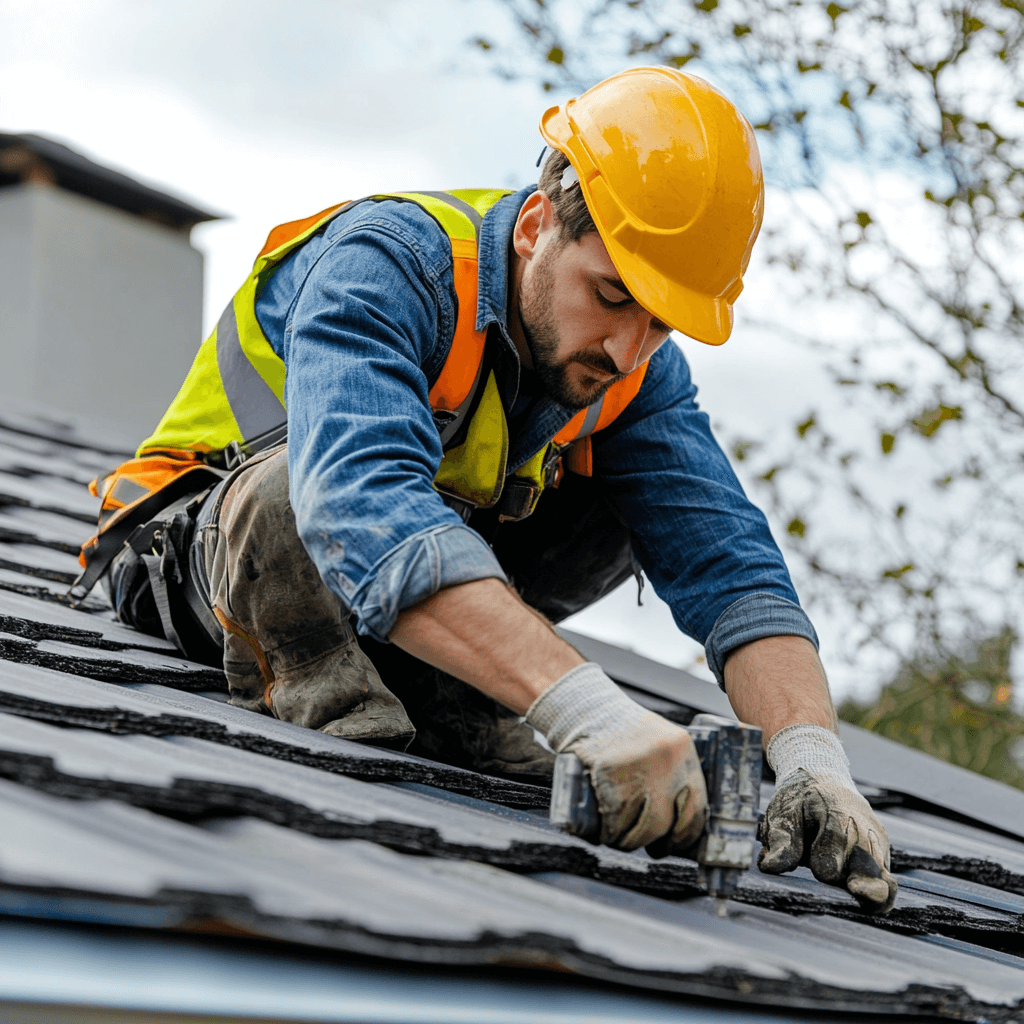Let’s Dive Into The world of TPO Roofing. Ever Heard of It? TPO stands for Thermoplastic Olefin. Sounds fancy, right? But it’s actually a type of single-ply roofing membrane that’s been taking the roofing world by storm. It’s like the cool new kid on the block, offering a modern and energy-efficient alternative to traditional roofing materials.
TPO roofing has gained massive popularity in recent years, especially for commercial buildings. But guess what? Homeowners are catching on too! Why? Because it offers a whole bunch of benefits that make it a smart choice for protecting your most valuable asset – your home.
So, what makes TPO roofing so special? It’s a durable, flexible, and reflective material that can withstand all sorts of weather conditions. Think of it as a superhero cape for your roof, shielding it from harsh UV rays, heavy rain, and even those pesky hailstorms. And the best part? It’s incredibly energy-efficient, which means you could save a bundle on your cooling bills during those scorching summer months. Sounds pretty awesome, doesn’t it?
Advantages of TPO Roofing: Why Choose TPO?
Energy Efficiency: Picture this – a white, reflective surface on your roof bouncing back the sun’s rays like a champ. That’s TPO in action! This reflectivity means your home absorbs less heat, keeping it cooler and reducing the workload on your air conditioner. Translation: lower energy bills and a happier wallet.
Durability & Longevity: TPO is tough as nails! It’s resistant to punctures, tears, UV damage, and even those nasty chemicals that can wreak havoc on other roofing materials. This means your TPO roof will stand the test of time, protecting your home for decades to come.
Weather Resistance: Mother Nature can throw a lot at your roof – scorching heat, freezing cold, torrential downpours, and even the occasional hail storm. But TPO roofing is designed to handle it all. It’s like a weatherproof shield for your home, keeping you safe and dry no matter what the forecast brings.
Environmental Benefits: TPO roofing is a sustainable choice. It’s often made with recycled materials and can be recycled at the end of its lifespan. Plus, its energy efficiency helps reduce your carbon footprint. Now that’s a win-win for both your home and the planet.
Easy Installation & Maintenance: Nobody wants a roofing project that drags on forever. TPO roofing is relatively quick and easy to install, minimizing disruption to your daily life. And once it’s up there, it requires minimal maintenance. Just a few routine checkups and cleaning, and your TPO roof will keep looking and performing its best for years to come.
So, there you have it! TPO roofing isn’t just another roofing option; it’s a smart investment in your home’s comfort, energy efficiency, and long-term protection.

TPO Roofing Installation Process: A Step-by-Step Guide
Now, we are not suggesting you DIY this one – it’s best left to the professionals. But understanding the process can help you appreciate the craftsmanship that goes into a quality TPO roof.
Step 1: Surface Preparation
Think of this as laying the groundwork for a masterpiece. Before any TPO membrane is laid down, the existing roof surface needs to be squeaky clean, dry, and smooth. This ensures proper adhesion and prevents any nasty surprises down the road.
Step 2: TPO Membrane Layering
Now comes the star of the show – the TPO membrane itself! This is usually rolled out in large sheets and carefully positioned on the roof. Special techniques are used to ensure proper adhesion and to create strong, watertight seams between the sheets.
Step 3: Sealing & Flashing
Think of this as reinforcing the armor. Flashing is installed around roof penetrations like vents, pipes, and skylights to prevent leaks. Seams are then sealed with heat or chemicals, creating a continuous, waterproof barrier.
Step 4: Drainage Considerations
Just like a well-designed landscape, a TPO roof needs proper drainage. This means ensuring that water flows smoothly off the roof, preventing ponding that can damage the membrane over time.
Step 5: Quality Control & Inspection
The final touch! A thorough inspection ensures that everything has been installed correctly and meets industry standards. This is your assurance of a top-quality TPO roof that will protect your home for years to come.
So, there you have it – a bird’s-eye view of the TPO roofing installation process. It’s a meticulous process that requires expertise and precision, but the end result is a durable, energy-efficient, and worry-free roof for your home.
TPO Roofing Cost Factors: What Influences the Price?
TPO roofing is an investment in your home, and like any investment, it’s important to understand the cost factors involved. Now, we can’t give you an exact figure without knowing the specifics of your roof, but I can break down the key elements that influence the overall price.
Roof Size & Complexity: This one’s pretty straightforward. The bigger your roof, the more materials and labor will be required, which translates to a higher cost. If your roof has a complex design with lots of angles, dormers, or skylights, that can also add to the complexity and expense of the installation.
TPO Membrane Thickness: TPO membranes come in different thicknesses, typically ranging from 45 to 80 mils (a mil is a thousandth of an inch). Thicker membranes generally offer greater durability and puncture resistance, but they also come with a higher price tag.
Insulation Requirements: Insulation is a crucial component of any roofing system, and TPO is no exception. The type and amount of insulation you choose will affect the overall cost.
Labor Costs & Contractor Fees: This can vary depending on where you live and the experience of the contractor you choose. It’s always wise to get multiple quotes from reputable TPO roofing contractors to compare prices and ensure you’re getting a fair deal.
Warranties & Additional Features: Some manufacturers offer warranties on their TPO membranes, which can add to the cost but also provide peace of mind. Additionally, there are optional features like reflective coatings or cool roof granules that can enhance the energy efficiency of your TPO roof, but these also come at an extra cost.
Remember, the best way to get an accurate estimate of your TPO roofing cost is to have a professional contractor inspect your roof and provide you with a detailed quote. It’s worth shopping around and comparing different options to find the best value for your investment.
You can consult with us our expert can estimate your roofing cost by clicking below
TPO vs. Other Roofing Options: How Does It Compare?
Now that you’ve got a good grasp of what TPO roofing is all about, let’s see how it stacks up against some of the other popular roofing options out there. Think of it as a head-to-head battle of the roofs!
TPO vs. EPDM:
EPDM (Ethylene Propylene Diene Monomer) is another type of single-ply membrane that’s been around for a while. It’s known for its affordability and durability. However, TPO often edges out EPDM in terms of energy efficiency due to its reflective surface. TPO also tends to have a longer lifespan and better resistance to punctures and tears.
TPO vs. PVC:
PVC (Polyvinyl Chloride) is a single-ply membrane that’s known for its flexibility and chemical resistance. However, it can be more expensive than TPO and may not be as energy-efficient. PVC is also more susceptible to UV damage, which can shorten its lifespan.
TPO vs. Other Roofing Options: How Does It Compare?
Now that you’ve got a good grasp of what TPO roofing is all about, let’s see how it stacks up against some of the other popular roofing options out there. Think of it as a head-to-head battle of the roofs!
TPO vs. Modified Bitumen:
Modified Bitumen is a multi-layer roofing system that’s known for its durability and waterproofing capabilities. However, it can be more complex and time-consuming to install than TPO. Modified Bitumen is also not as reflective as TPO, meaning it may not offer the same level of energy efficiency.
Choosing a TPO Roofing Contractor in Sacramento
Installing a TPO roof isn’t exactly a DIY project. You’re going to need the expertise of a qualified professional to get the job done right. But with so many roofing contractors out there, how do you choose the right one for your TPO project? Don’t worry, I’ve got you covered. Here are a few key things to look for:
Experience & Expertise:
TPO roofing requires specific knowledge and skills. Look for a contractor who specializes in TPO installations and has a proven track record of successful projects. Ask for references and check out online reviews to gauge their experience and expertise.
Licensing & Insurance:
This is non-negotiable. Make sure the contractor you choose is licensed and insured in your area. This protects you from liability in case of accidents or damage during the installation process.
References & Reviews:
Don’t just take the contractor’s word for it. Ask for references from past clients and check online review platforms like Google or Yelp. This can give you valuable insights into the contractor’s reputation, workmanship, and customer service.
Warranties & Guarantees:
A reputable TPO roofing contractor should stand behind their work with warranties and guarantees. Ask about the warranties offered on both the materials and the labor. This can give you peace of mind knowing that you’re protected in case of any issues down the road.
Communication & Transparency:
A good contractor will communicate clearly and transparently throughout the entire process. They should explain the project timeline, costs, and any potential challenges upfront. Avoid contractors who are vague or evasive.
By taking the time to research and select a qualified TPO roofing contractor, you’ll be well on your way to enjoying a beautiful, durable, and energy-efficient roof for your home.
Conclusion
Is TPO roofing the right choice for your home? The answer, like most things in life, isn’t a simple yes or no. It depends on your specific needs, budget, and priorities. If you’re looking for a durable, energy-efficient, and environmentally friendly roofing option that can withstand the elements and save you money on energy bills, then TPO roofing is definitely worth considering.
If you’re still unsure, don’t hesitate to reach out to a Norcal roofing professional for a free consultation. We can assess your roof, discuss your needs and budget, and help you determine if TPO roofing is the right fit for your home.
In the end, the decision is yours. But with its impressive benefits and growing popularity, TPO roofing is definitely a strong contender for the title of “best roof for your home.”



